Important Message
This Website Terms and Condition of Use Agreement
also known as a 'terms of service agreement'
Will be at the bottom of most web pages!
Please read it before using this website.
Thank You
|
William Boyd as (Hopalong Cassidy):
By the mid-1940’s, tall, black-clad, grey-haired, Hoppy & his faithful horse Topper became household names in more than 50 big screen westerns for movie producer Harry Sherman. From 1949 - 1952 William adapted Hoppy to the small screen with great success.
|
Birth Name: William Boyd
Date Of Birth: 5th June 1895
Place Of Birth: Hendrysburg, Ohio, USA
Date Of Death: 12th September 1972
Place Of Death:
Laguna Beach, California, USA
Height: 6’
Nickname: Hoppy
Spouses:
Grace Bradley (1937 - 1972)
Dorothy Sebastian (1931 - 1935)
Elinor Fair (1926 - 1929)
Ruth Miller (1921 - 1924)
His widow:
Grace Bradley Boyd
|
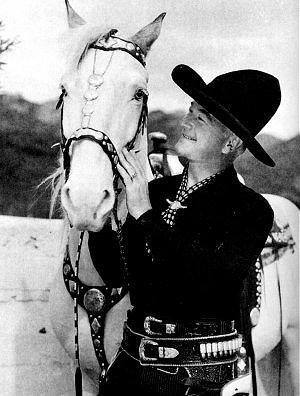 |
| Hopalong Cassidy |
|
|
|
|
William Boyd’s Top 10 Movies
|
 |
 |
|
Hop-A-Long Cassidy (1935)/Bar 20 Rides Again [DVD](1935) DVD
White-haired whitehat William Boyd debuts as Clarence E. Mulford's veteran cowpoke whose limp earned him the nickname "Hopalong" (and was rarely seen after this film), in the first of over 60 movies made over 13 years. Here Boyd and the gang of the Bar 20 Ranch must stop a crooked foreman's cattle-rustling pals from starting a range war. With James Ellison, George "Gabby" Hayes. AKA: "Hopalong Cassidy Enters." Then, Hoppy and his Bar 20 cowpokes must pluck the plans of a chicken-hearted cattle rustler named Purdue, who's out to make himself into a frontier Napoleon, in an exciting sagebrush thriller. Jimmy Ellison, Harry Worth, and George "Gabby" Hayes as "Windy" also star. 123 min. total. Standard; Soundtrack: English Dolby 5.1.
Three On The Trail (1936)/Hopalong Cassidy Returns (1936)
William Boyd's Hopalong Cassidy jumps into action when a town's sheriff turns his head after a group of cattle-rustling stagecoach thieves wreak havoc. Jimmy Ellison, Onslow Stevens and "Gabby" Hayes also star. Then, Cassidy finds he's falling for glamorous dance hall owner Evelyn Brent, unaware that she's the head of a ruthless gang of outlaws, in an early series entry that features a powerful and (for a "Hoppy" film) brutal ending that puts it among the series' best. With "Gabby" Hayes, Stephen Morris (later Morris Ankrum). 141 min. total. Standard; Soundtrack: English Dolby 5.1.
Call Of The Prairie (1936)/Heart Of The West (1936)
The call is a cry for help when a group of outlaws causes all sorts of trouble, and Hopalong Cassidy and his pals are pressed into action to save the day. Jimmy Ellison, Muriel Evans, "Gabby" Hayes and Chill Wills and the Avalon Boys also star. Then, you've gotta have "heart" to be a Wild West rancher, but a little help from "Hoppy" won't hurt, either. That's what frontierswoman Lynn Gabriel learns when Hopalong Cassidy and pals Jimmy Ellison and Gabby Hayes help her save her spread from a rascally neighbor. 122 min. total. Standard; Soundtrack: English Dolby Digital mono.
Hills Of Old Wyoming (1937)/North Of The Rio Grande (1937)
These hills are alive--with the sounds of a shady deputy who's using half-breed Indians to run his cattle-rustling scheme. It's up to Hopalong Cassidy and sidekicks "Gabby" Hayes and Russell Hayden to catch the owlhoots and smooth things between cattlemen and Indians. Then, odds are North of the Rio Grande'll put you in Texas, pardner, and that's where Hopalong Cassidy finds himself when he poses as an outlaw to bring in the crooks who killed his brother. With Russell Hayden, "Gabby" Hayes, and Lee J. Cobb (his film debut). 149 min. total.
Trail Dust (1936)/Borderland (1937)
There's plenty of dust--and justice--kicked up when Hopalong Cassidy, "Gabby" Hayes and James Ellison saddle up and take on some low-down rannies out to keep a cattle drive from reaching its goal. Look for a pre-sidekick days Al St. John as one of the bad guys. Then, what's this? Heroic Hopalong Cassidy drinking and being mean to kids? Not to worry, Western fans--it's all due to Hoppy's undercover identity, part of a scheme to flush out an outlaw gang plaguing the border territories. "Gabby" Hayes and Jimmy Ellison (in his final film in the series) co-star. 159 min. total.
Rustlers' Valley (1937)/Texas Trail (1937)
First, it was the lawyer who really pulled the bank job...and Hopalong Cassidy is determined to prove it--while saving the ranch and the girl. William Boyd, "Gabby" Hayes and Agnes Glenn star. Then, an unusual entry in the "Hopalong Cassidy" series has Hoppy and the Bar 20 boys helping out the Army during the Spanish-American War by rounding up horses for the Rough Riders to use. With William Boyd, "Gabby" Hayes, Russell Hayden. 131 min. total. Standard; Soundtrack: English Dolby Digital mono; photo gallery; publicity materials; theatrical trailer.
Cassidy Of Bar 20 (1938)/Partners Of The Plains (1938)
That's "Cassidy" as in "Hopalong," pardner, who rides into danger when he helps an old flame whose ranch is being terrorized by rustlers. Russell Hayden, Nora Lane, Robert Fiske also star. Then, one of the stronger installments of his series finds Hopalong Cassidy lending his services to an English lady who has inherited a ranch and taking care of her pesky little villain problem. Harvey Clark, Russell Hayden, Gwen Gaze also star. 127 min. total. Standard; Soundtrack: English Dolby Digital mono.
Hopalong Rides Again (1937)/Heart Of Arizona (1938)
First, Hoppy's got a bone to pick with the head of a cattle-nabbing gang who poses as a paleontologist to learn about the Bar 20's plans to move 1,000 head of cattle through rustler territory. With William Boyd, "Gabby" Hayes, Russell Hayden. Then, notorious lady outlaw Belle Starr gets out of jail and tries to fly right as a rancher, but when things go wrong only Hopalong Cassidy can set them straight. With William Boyd, "Gabby" Hayes and Natalie Moorhead. 131 min. total. Soundtrack: English Dolby Digital mono; photo gallery; publicity materials; theatrical trailer.
Pirates On Horseback (1941)
A gambling tycoon attempts to defraud a cowpoke causing Hopalong Cassidy, Lucky Jenkins and California to come to his defense. A highlight of the sagebrush saga is a terrific fistfight between Hoppy and the gambler. Russell Hayden, Andy Clyde and Morris Ankrum co-star. 69 min.
Bar 20 (1943)
The title, as every good western fan knows, refers to Hopalong Cassidy's ranch, and in this action-packed oater Hoppy's plans to buy some cattle for his spread hit a snag when he first must corral a gang of stagecoach robbers. Helping Cassidy are Andy Clyde and future Superman George Reeves; with Victor Jory, Dustin Farnum and Robert Mitchum (playing a good guy for once). 58 min.
|
|
Reel Cowboys of the Santa Susanas -- William Boyd (Hopalong Cassidy)
William Boyd (1895 – 1972) was a B-Western star who was best known for his portrayal of Hopalong Cassidy.
In 1935, Boyd won the title role for the original Hopalong Cassidy movie, and went on to make 66 films ending in 1947. He even produced the final 12 films.
Believing in television's potential, he purchased the rights to the Hopalong Cassidy character (including books and films) for $350,000, and released the films to television in 1949. They became extremely popular and began a long-running history on television. Like Rogers and Autry, Boyd licensed much merchandise, including such products as Hopalong Cassidy watches, trash cans, cups, dishes, Topps trading cards, a comic strip, comic books, radio shows and cowboy outfits. Boyd so completely identified with his character that he dressed as Hoppy in public.
Bill's Santa Susanas locations filmography
Dangerous Venture (1947) - William Boyd - United Artists
Lumberjack (1944) - William Boyd with Andy Clyde (Iverson Ranch)(photo above) United Artists
The Marauders (1947) - William Boyd (Iverson Ranch)(photos above and below) United Artists
Mystery Man (1944) - William Boyd (Iverson scenes) United Artists
The Showdown (1940) - William Boyd (Iverson Ranch)
Undercover Man (1942) - William Boyd (Iverson Ranch)(lobby photos above and below)
Several of the "Hopalong Cassidy TV Series" (1952–1954) episodes had outdoor scenes filmed on the Iverson Ranch.
|
Hopalong Cassidy is a fictional cowboy hero created in 1904 by the author Clarence E. Mulford, who wrote a series of popular short stories and many novels based on the character.
In his early writings, Mulford portrayed the character as rude, dangerous, and rough-talking. Beginning in 1935, the character—as played by movie actor William Boyd in films adapted from Mulford's books—was transformed into a clean-cut on-screen hero. A total of sixty-six immensely popular films were released, only a few of which relied on Mulford's original story lines. Mulford later revised and republished his earlier works to be more consistent with the character's new, polished on-screen persona.
| |
Film history
| Hopalong Takes Command, illustration by Frank Schoonover for the 1905 story “The Fight at Buckskin.”
|
As portrayed on the screen, the white-haired Bill "Hopalong" Cassidy was usually clad strikingly in black (including his hat, an exception to the longstanding western film stereotype that only villains wore black hats). He was reserved and well spoken, with a fine sense of fair play. He was often called upon to intercede when dishonest characters were taking advantage of honest citizens. "Hoppy" and his white horse, Topper, usually traveled through the west with two companions—one young and trouble prone with a weakness for damsels in distress, the other comically awkward and outspoken.
The juvenile lead was successively played by James Ellison, Russell Hayden, George Reeves, and Rand Brooks. George Hayes (later to become known as "Gabby" Hayes) originally played Cassidy's grizzled sidekick, Windy Halliday. After Hayes left the series because of a salary dispute with producer Harry Sherman, he was replaced by the comedian Britt Wood as Speedy McGinnis and finally by the veteran movie comedian Andy Clyde as California Carlson. Clyde, the most durable of the sidekicks, remained with the series until it ended. A few actors of future prominence appeared in Cassidy films, most notably Robert Mitchum, who appeared in seven of the films at the beginning of his career.
The sixty-six Hopalong Cassidy pictures were filmed by independent producers who released the films through the studios. Most of the "Hoppies," as the films were known, were distributed by Paramount Pictures to highly favorable returns. They were noted for their fast action and excellent outdoor photography (usually by Russell Harlan). Harry Sherman was anxious to make more ambitious movies and tried to cancel the Cassidy series, but popular demand forced Sherman to go back into production, this time for United Artists release. Sherman gave up the series once and for all in 1944, but William Boyd wanted to keep it going. To do this, he gambled his entire future on Hopalong Cassidy, mortgaging virtually everything he owned to buy both the character rights from Mulford and the backlog of movies from Sherman.
In the first film, Hopalong Cassidy (then spelled "Hop-along") got his name after being shot in the leg. Hopalong's "drink of choice" was the nonalcoholic sarsaparilla.
|
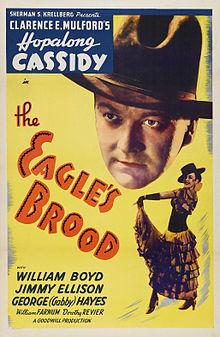 |
| Poster for the 1935 Hopalong Cassidy film The Eagle's Brood. |
|
|
Boyd resumed production in 1946, on lower budgets, and continued through 1948, when "B" westerns in general were being phased out. Boyd thought that Hopalong Cassidy might have a future in television, spent $350,000 to obtain the rights to his old films, and approached the fledgling NBC television network. The initial broadcasts were so successful that NBC could not wait for a television series to be produced and simply reedited the old feature films down to broadcast length. On June 24, 1949, Hopalong Cassidy became the first network Western television series.
The enormous success of the television series made Boyd a star. The Mutual Broadcasting System began broadcasting a radio version of Hopalong Cassidy, with Andy Clyde (later George MacMichael on Walter Brennan's ABC sitcom The Real McCoys) as the sidekick, in January 1950; at the end of September, the show moved to CBS Radio, where it ran until 1952.
The series and character were so popular that Hopalong Cassidy was featured on the cover of national magazines, such as Look, Life, and Time. Boyd earned millions as Hopalong ($800,000 in 1950 alone), mostly from merchandise licensing and endorsement deals. In 1950, Hopalong Cassidy was featured on the first lunchbox to bear an image, causing sales for Aladdin Industries to jump from 50,000 units to 600,000 units in just one year. In stores, more than 100 companies in 1950 manufactured $70 million of Hopalong Cassidy products, including children's dinnerware, pillows, roller skates, soap, wristwatches, and jackknives.
|
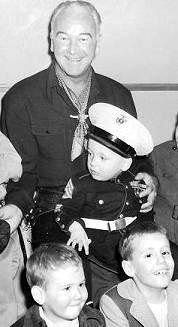 |
| William Boyd |
|
|
There was a new demand for Hopalong Cassidy features in movie theaters, and Boyd licensed reissue distributor Film Classics to make new film prints and advertising accessories. Another 1950 enterprise saw the home-movie company Castle Films manufacturing condensed versions of the Paramount films for 16-mm and 8-mm projectors; they were sold through 1966. Also, in January 1950 Dan Spiegel began to draw a syndicated comic strip with scripts by Royal King Cole; the strip lasted until 1955.
Boyd began work on a separate series of half-hour westerns made especially for television; Edgar Buchanan was his new sidekick, Red Connors (a character from the original stories and a few of the early films). The theme music for the television show was written by veteran songwriters Nacio Herb Brown (music) and L. Wolfe Gilbert (lyrics). The show ranked number 7 in the 1949 Nielsen ratings. The success of the show and tie-ins inspired several juvenile television westerns, such as The Range Rider, Tales of the Texas Rangers, Annie Oakley, The Gene Autry Show, and The Roy Rogers Show.
After Boyd's death, his company devoted to Hopalong Cassidy, U.S. Television Office, retained control of the entirety of Cassidy films but, by the mid-1960s, had withdrawn them from television availability and sales in any of the home movie markets. This remained the situation until the mid-1990s, after many of the loyal Cassidy fans had died, when the company's officers made available to The Western Channel a package series of restored and cleaned negative-based prints of the films to cable TV viewers. These remained available on that channel until 2000, when they were again withdrawn. Minimal effort was made at that time, nor has it been made since, to offer the films for private purchase on home video, excepting two packages of compressed, multi-title Hopalong Cassidy anthology DVDs, the first requiring purchase of the entire TV series in order to obtain copies of about a dozen films and then, in 2014, a reissuance of the remaining stock of these same DVD pressings combined with the remaining titles in a first-time pressing.
|
|
Chicago (circa 1950)
|
| Born |
William Lawrence Boyd
(1895-06-05)June 5, 1895
Belmont County, Ohio. U.S. |
|---|
| Died |
September 12, 1972(1972-09-12) (aged 77)
Laguna Beach, California, U.S. |
|---|
|
Cause of death
|
complications from Parkinson's disease and heart failure |
|---|
|
Resting place
|
Forest Lawn Memorial Park Cemetery |
|---|
| Years active |
1918-1954 |
|---|
| Spouse(s) |
Laura Maynard
(m.1917-1921; divorced)
Ruth Miller
(m.1921-1924; divorced)
Elinor Fair
(m.1926-1929; divorced)
Dorothy Sebastian
(m.1930-1936; divorced)
Grace Bradley
(m.1937-1972; his death |
|---|
|
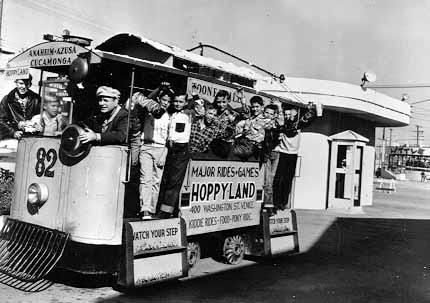 |
| The Hoppyland tram transports patrons to and from the parking lot. 1951 |
|
|
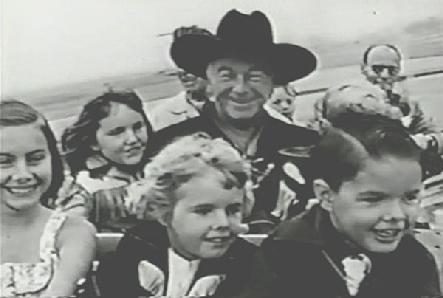 |
| Hoppyland - Hoppy & several movie star's children. |
|
|
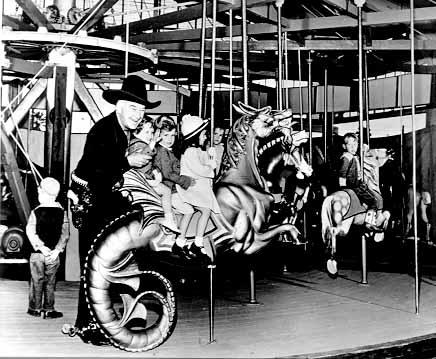 |
| Actor William Boyd "Hoppalong Cassidy" poses with children on opening day. The carousel is a rebuilt E. Joy Morris menagerie machine. - 1951 |
|
|
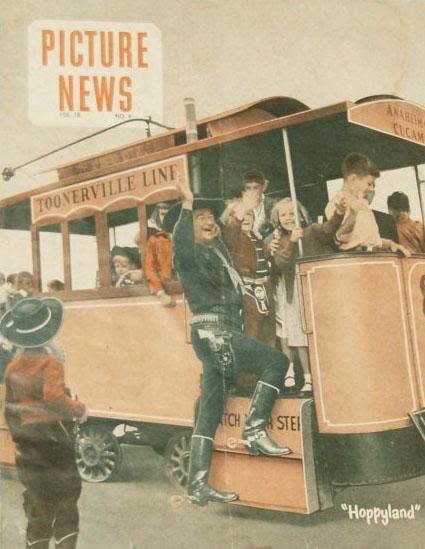 |
| Hoppyland - Web Site |
|
|
On May 26, 1951, an amusement park named Hoppyland opened in the Venice section of Los Angeles. This was an expansion and retheming of Venice Lake Park (opened the previous year) as Boyd became an investor. Standing on some 80 acres (320,000 ) it included a roller coaster, miniature railroads, pony rides, boat ride, Ferris wheel, carousel, and other thrill rides along with picnic grounds and recreational facilities. Despite Boyd's regular appearances as Hoppy at the park, it was not a success and shut down in 1954.
|
William “Bill” Boyd, known best for playing the famous Hopalong Cassidy, prided himself in setting good examples to all youngsters who watched him on television or on the big screen. However, he didn’t always follow that straight and narrow path.
When Boyd first entered the Hollywood spotlight, and celebrity status took hold, he did what many young, rich, good-looking actors of Hollywood did and still continue to do; he partied continuously with friends and spent lavishly with little regard to his future finances. It wasn’t until Boyd accepted the role of children's hero Hopalong Cassidy that he voluntarily changed his ways. When Boyd began playing the role, he changed the cowboy from a drinking, smoking, gambling, swearing gunslinger to a respectable hero who never swore, never drank, never smoked, and never started the fight. He also made some personal decisions as well. He figured if his character didn’t do any of these things, than he shouldn’t either.
Before becoming Hoppy, everything was working out fantastically for Bill until another actor who went by the name William Boyd entered the Hollywood scene and almost cost Bill his good name and image. This William Boyd was a mean drunk who liked to pick fights and was constantly in trouble for his quarrelsome behavior. Neither of the Boyd’s agreed to change their name, even though the press confused the two on a regular basis. Finally, to alleviate some of the confusion, Bill was listed as William “Bill” Boyd and the other was listed as William “Stage” Boyd, because he got his big break as a stage actor performing in New York.
One day newspapers across the country released a news article stating that William H. Boyd was charged with drug and alcohol possession, gambling equipment, and pornography. Since this occurred during the time of prohibition, alcohol was an illegal substance, as were roulette wheels, and any other gambling devices. The papers claimed that L.A. police raided the actor’s home during a night while he was throwing a wild party. One newspaper even reported that when Boyd answered the door he knocked the lead officer right to the ground. Men and women in attendance scattered throughout the house in an attempt to escape charges. Police were not concerned with those fleeing out windows and back doors, but they did arrest “Stage” Boyd, Pat O’Brian, an actor who frequently played the role of priests, and Walter Catlett, an actor who usually portrayed snobbish types. Needless to say, newspapers raced to the opportunity to expose Boyd’s naughty doings. Unfortunately for William “Bill” Boyd, they ran his picture by mistake with the headline, “Bill Boyd Held For Gambling” underneath. The mistake nearly cost Hoppy his career, not to mention his heroic reputation.
More great Bill Boyd stories are on their way...
|
My Birthday Party (1953)
I'm a 5 year old Hop-a-long Cassidy
|
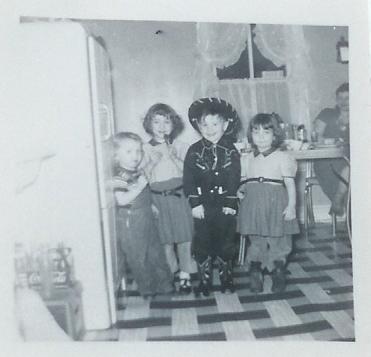 |
| Thanks for stopping by today.. |
|
|
This website contains, in various sections, portions of copyrighted material not specifically authorized by the copyright owner. This material is used for educational purposes only and presented to provide understanding or give information for issues concerning the public as a whole. In accordance with U.S. Copyright Law Title 17 U.S.C. Section 107, the material on this site is distributed without profit. More Information
Information presented based on medical, news, government, and/or other web based articles or documents does not represent any medical recommendation or legal advice from myself or West Saint Paul Antiques. For specific information and advice on any condition or issue, you must consult a professional health care provider or legal advisor for direction.
I and West Saint Paul Antiques can not be responsible for information others may post on an external website linked here ~ or for websites which link to West Saint Paul Antiques. I would ask, however, that should you see something which you question or which seems incorrect or inappropriate, that you notify me immediately at floyd@weststpaulantiques.com Also, I would very much appreciate being notified if you find links which do not work or other problems with the website itself. Thank You!
Please know that there is no copyright infringement intended with any part of this website ~ should you find something that belongs to you and proper credit has not been given (or if you simply wish for me to remove it),
just let me know and I will do so right away.
|
Website Terms and Condition of Use Agreement
also known as a 'terms of service agreement'
By using this website, West Saint Paul Antiques . Com, you are agreeing to use the site according to and in agreement with the above and following terms of use without limitation or qualification. If you do not agree, then you must refain from using the site.
The 'Terms of Use' govern your access to and use of this website and facebook pages associated with it. If you do not agree to all of the Terms of Use, do not access or use the website, or the facebook sites. By accessing or using any of them, you and any entity you are authorized to represent signify your agreement to be bound by the Terms of Use.
Said Terms of Use may be revised and/or updated at any time by posting of the changes on this page of the website. Your continued usage of the website, or the facebook site(s) after any changes to the Terms of Use will mean that you have accepted the changes. Also, any these sites themselves may be changed, supplemented, deleted, and/or updated at my sole discretion without notice; this establishes intellectual property rights by owner (myself).
It saddens me to include a Terms of Use for West Saint Paul Antiques . Com, but we all realize it is something that is necessary and must be done these days. By using the website, or facebook for West Saint Paul Antiques, you represent that you are of legal age and that you agree to be bound by the Terms of Use and any subsequent modifications. Your use of the West Saint Paul Antiques sites signify your electronic acceptance of the Terms of Use and constitute your signature to same as if you had actually signed an agreement embodying the terms.
|
|